Massacre Time (1966)
Directed by: Lucio Fulci
Written by: Enzo Dell'Aquila, Fernando Di Leo, Lucio Fulci
Starring: Franco Nero, George Hilton, Giuseppe Addobbati, Nino Castelnuovo
AKA LE COLT CANTARONO LA MORTE E FU…TEMPO DI MASSACRO, THE COLT SANG DEATH AND IT WAS….MASSACRE TIME, THE BRUTE AND THE BEAST
ITALY
AVAILABLE ON DVD
RUNNING TIME: 92 mins
REVIEWED BY: Dr Lenera
Tom Corbett is prospecting for gold when he receives a message telling him to return to the family home in Laramie Town that his mother bequeathed to his estranged brother Jeff while sending Tom away. Upon arriving there, Tom is shocked to discover that the now dilapidated house, not to mention most of the town, is owned by land-grabber Mr Scott, whose psychopathic son Jason terrorises the locals. And Jeff has become a drunken wreck who lives in a run down shack with Native American wet nurse Mercedes. Of course Tom and Junior soon seem to be heading for a conflict….
I don’t know why it’s taken me this long, in my Lucio Fulci review series, to get to one of his Westerns, but anyway here’s a write-up of the first of the three films he made in the genre, the other two being Four Of The Apocalypse and Silver Saddle. Four Of The Apocalypse sounds great and seems to be generally considered the best, but Massacre Time is definitely no slouch and shows that Fulci had a real feel for the western even though I wouldn’t agree with the man himself who claimed that he’d made an “an oneric western” and “a western beyond space and time”. Okay Lucio whatever. While one can certainly spot some elements of his style, not to mention his fascination with brutal violence [and there was I thinking that the latter began with Fulci’s next film, the stunning Beatrice Cenci], it’s not atypical of the hordes of Italian ‘oaters’ coming out at this time. But despite obviously having a lower budget than some, it has some fine action, a decent story line, good performances by George Hilton and Nino Castelnuovo, and a cool soundtrack. One thing I should say right now though; two English dubs exist and one is far, far superior to the other, the latter being so detrimental to my enjoyment of the film that I switched over to the former after about ten minutes. The ‘International Dub’ which was done in Italy for export release has terrible voicing and was considered to be so poor that the US distributors American International Pictures put together one of their own which is really rather good as these things go, just like the dubs they did for some Godzilla films being far better than Toho’s dubs – though that’s a sadder case because those control freaks at Toho won’t let them be released. Fortunately the Wild East DVD contains both dubs even if all other releases are of the International one.
Its title was taken from the novel ‘Tempo di massacaro’ by Franco Enna, though the script by Fernando Di Leo, who later made a name for himself with his ‘poliziotteschi’ films in the ’70s, used very little of it. This was Di Leo’s first his first solo screenplay credit, though his former writing partner Enzo Dell’Aquila and Fulci made un-credited contributions. Fulci would later claim that he pushed Di Leo to make the script as violent as possible, though Di Leo refuted this. It was originally supposed to be an Italian-Spanish co-production with A Pistol For Ringo co-star George Martin attached to the leading role of Tom, but the Spanish co-producers withdrew their involvement and funding after Fulci refused to tone down the script’s violence at their behest, something which prevented Martin from taking the role. Having decided to then shoot the film entirely in Italy on a lower budget, Fulci instead cast Nero at the suggestion of his assistant director, Giovanni Fago, on the basis of production stills from Django which had recently been a big hit for Nero. Hilton, making his film debut and cast largely because he looked like Gary Cooper, later described Fulci as “a difficult man to work with” with an “overbearing personality and that could be difficult” – which probably won’t come as surprise to some, in fact it’s a wonder he made as many films as he did considering what he reportedly was like. The shoot was hard-going with cast and crew living in desolate locations with virtually no facilities. Massacre Time did solid business and, under the title The Brute And The Beast, was one of only two spaghetti westerns imported to the United States by American International, the other being God Forgives… I Don’t!. In Germany and Denmark it was released as one of the many unofficial Django sequels, while some story elements were tweaked and reused the same year in Texas, Adios, also starring Nero.
We open with what’s basically Fulci’s version of The Most Dangerous Game, a short story from 1924 by Richard Connell which has been often filmed though usually re-titled, and was the basis for this year’s The Hunt. Rich-looking men atop horses with a pack of braying dogs release a beaten man from a wooden cage and give him a small amount of time to get some distance away from them before giving chase. Eventually the dogs get him in a lake, obviously ripping him to bits with lots of blood on evidence even if we don’t see much detail [Fulci saved that for a similar scene in Beatrice Cenci]. Probably more disturbing is the way the leader of the pack Jason tilts his head and rolls his eyes back; he seems to be getting some sexual satisfaction from the sight. The credits then appear over the man’s blood washing downstream, taking us many miles away until we’re at another lake where Tom and some others are looking for gold. Tom has to leave because of this mysterious letter demanding that he return home even though his dead mother forbade it, but soon finds himself in a town where every building seems to show a particular ‘S’ sign, meaning that it’s the property of Scott, and people warn him not to trespass. Jason and his gang of bullies ride in to torment a family who’s leaving because they’re not being paid enough and shoot dead the son, but Tom doesn’t interfere. Some might be disappointed at the way Nero’s character holds back on drawing forth his gun for quite a while, but the suspense is built quite well and, while Nero is as stoic as he usually was in his earlier roles, trying with limited success to channel Clint Eastwood, Hilton gives a fine comic performance as the permanently pissed Jeff, and looks like he’s doing everything himself too, which of course makes it more exciting when Jeff is leaning out of his saddle firing away at bad guys.
Both Jeff and Mercedes insist that Tom leave immediately and refuse to discuss why he’s been summoned, but of course Tom hangs around, leading to a bar brawl where Jeff is still able to handle himself despite being blotto. But despite Tom helping Jeff out, Jeff still wants him to leave, and then Tom visits the Carradine family because the grandfather was the person who sent him the letter – with catastrophic results. What’s to do then but go to Mr Scott himself, leading to what is possibly Fulci’s first scene of prolonged violence, where Tom and Jason duel with whips. Jason, due to not playing fair, quickly gets the upper hand and just won’t stop whipping Jason, with the impact of some of the lashes being shown, while all the time well-dressed, dandified onlookers watch with joy. Who knows why Fulci developed such a fascination with sustained brutality of a far more gloating fashion than many other film directors, and even before he lost his wife and daughter in 1968. Tom’s wounds seem to heal too quickly – if much time is supposed to have passed, then the film doesn’t manage to convey this. The way that Jeff keeps on leaving Tom before then popping up to help him and in more than one case save his life is also a little daft, unless of course this was intended to be funny. Indeed, despite the general gritty feel, there are some intentionally amusing touches, first and foremost among them being Sonko, an undertaker/blacksmith who spouts his own twists on Chinese sayings such as:“Confucius say, burying the dead is a gratuitous and pointless task, but Confucius, he dead, I live in this town not him”. The character works as light relief without unbalancing the serious nature of things, and it’s a real shame that he disappears from the film. Also funny is Jeff repeatedly proclaiming “excuse me gentlemen” in a friendly manner before opening fire on his quarry as if he’s trying to give them a fighting chance, and starting to drink from a bottle of whisky before throwing it away in horror because sambuca is his thing.
The big climactic gunfight is a fast and athletic one with our heroes rush all over the place while we’re treated to plentiful shots of bullets hitting people in close-up, sometimes their faces. It sometimes gets silly – at one point Tom is firing at some opponents while in a wagon moving on its own when the wagon hits a wall and Tom is hurled into the air before cutting to him – or Nero’s stuntman – then landing on his feet! It almost feels like you’re watching a John Woo film at times what with the way our heroes fall all over the place but are still able to shoot while doing so, the emptying of guns into a single person at close range, even some birds flying above. The final act is also home to some revelations which may as a surprise to some. I saw one of them coming, and we’re left with some details remaining rather sketchy, though all in all it works okay as a story. Of course a film like this is only as good as its villain and Nino Castelnuovo certainly doesn’t disappoint, acting convincingly psychotic without over doing it as Jason. Whenever I watch The Umbrellas Of Cherbourg I’m always surprised that Catherine Deneuve went on to become a huge star while Castelnuovo, despite being the better performer, had limited success by comparison. Though there are several unusual family relationships in the film, the most interesting is that of Jason and his father. Dad has clearly spoilt and indulged his son to excess, something which might be responsible for Jason having become such a monster. A scene where they both play the piano has a slight oedipal touch about it. As is sometimes the case, there’s little room for women; Mercedes the nurse has a few scenes, and there are just a couple of exchanges with prostitutes who work in the saloon.
A few awkward edits both visual and aural suggest that the film was cut down [maybe the third-billed Sini originally had a bigger part as one of the hookers?], but seeing as I found no information on a longer version, the edits must have been made prior to release. The town set looks rather thrown up but some effort was made with the costumes – minor characters sometimes sport interesting details while Nero’s black outfit is one of his coolest. Composer Coriolano Gori is not one that I’ve heard of but his work is really good; there’s a rousing Ennio Morricone-like main theme [though I could have lost the lyrics during the main titles] employed in several guises, a more comical [but without being intrusive] one for Jeff, and some moody suspense. Fulci and cinematographer Riccardo Pallottini like to have a face in closeup while other characters are in the background, giving a slight 3d feel. One nice shot has a head loom out of the screen on the right before two other men emerge from behind the head much further away. His style isn’t yet as distinctive as Sergio Leone’s or even the likes of Sergio Corbucci, but it’s definitely there, and I still can’t get my head around the care and technical skill of Fulci’s earlier output compared with the sloppiness and laziness of much of his later stuff, even though I know it was mostly the result of much illness combined with tiny budgets. Whether Massacre Time is a classic in the spaghetti western genre is doubtful, but I found very little to dislike about it and had a pretty good time throughout. Being the un-PC type that I am, I even rather liked the way that Jeff keeps on drinking throughout [to no objection from anybody] and ends the film as the alcoholic that he was at the beginning. Usually he’d have to be seen kicking his habit and finishing the film totally clean!
Rating: 










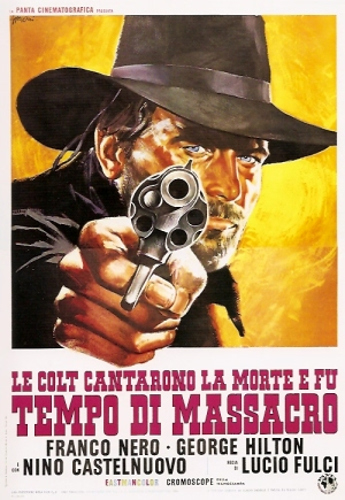
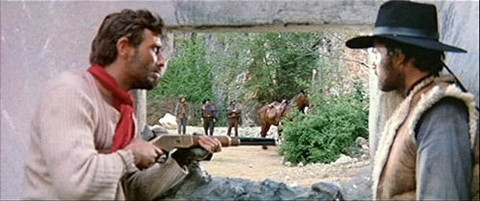
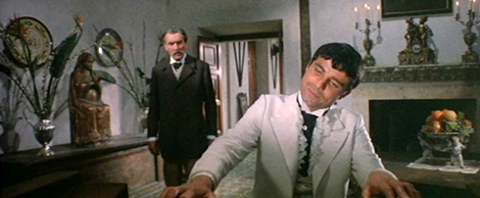

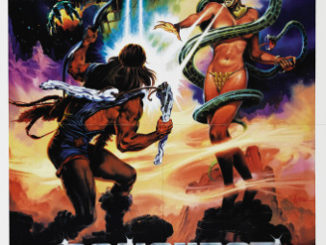
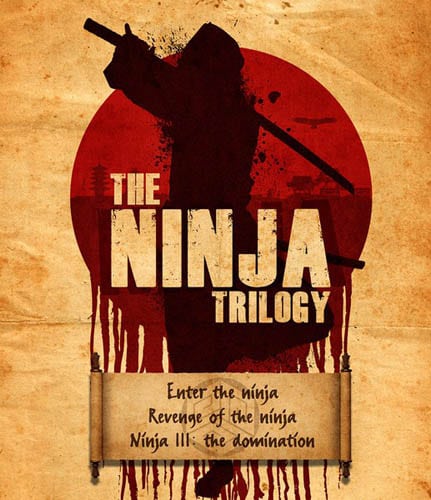

Be the first to comment